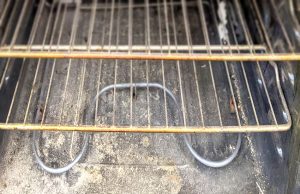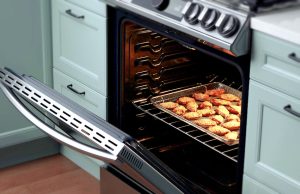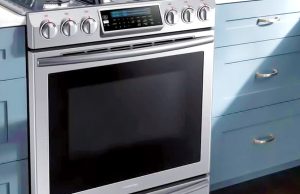Some of our posts contain affiliate links. If you buy through our links, I may earn a small commission at no extra cost to you.
How to Use a Bread Knife: A Beginner’s Guide
Using a bread knife may seem like a simple task, but there’s an art to achieving those perfect, even slices. In this beginner-friendly guide, we’ll break down the basics of how to use a bread knife with ease.
From selecting the right knife to mastering the proper technique, you’ll soon be cutting through loaves like a pro. Whether you’re a novice in the kitchen or just looking to up your bread game, this step-by-step tutorial will have you confidently wielding your bread knife and enjoying consistently beautiful slices.
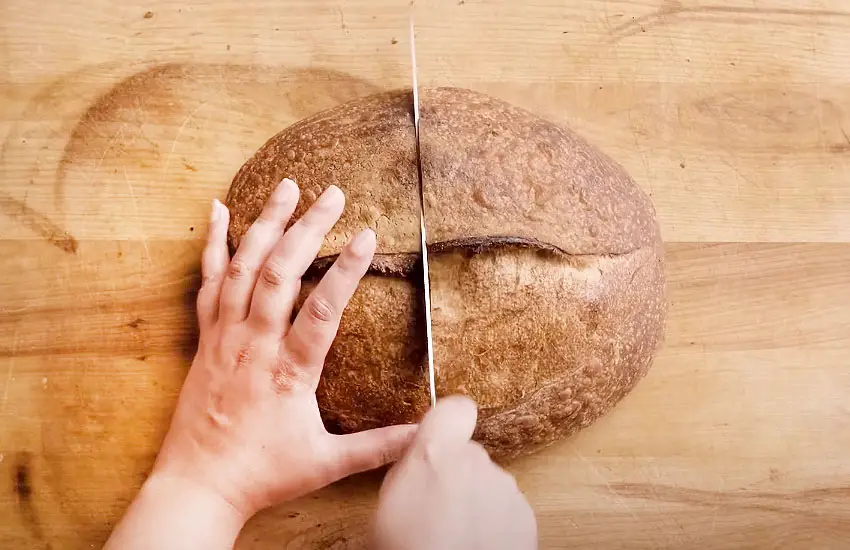
Types of Bread Knives
Bread knives come in various types, each designed to optimize the slicing of different types of bread. Understanding the various types of bread knives and their specific uses can help you make the most of this essential kitchen tool.
Serrated Blade
A serrated blade is the most common type of bread knife, recognized by its toothed edge. The serrated blade allows for a sawing motion, perfect for cutting through crusty bread without crushing it.
Offset Blade
The offset blade features an angled handle that keeps your hand elevated and away from the cutting board, providing more comfortable and efficient slicing. This design helps maintain a natural wrist position, reducing strain during prolonged use.
Choosing the Right Bread Knife
A bread knife is essential for slicing bread easily and efficiently. Learn how to use a bread knife properly for perfect slices every time.
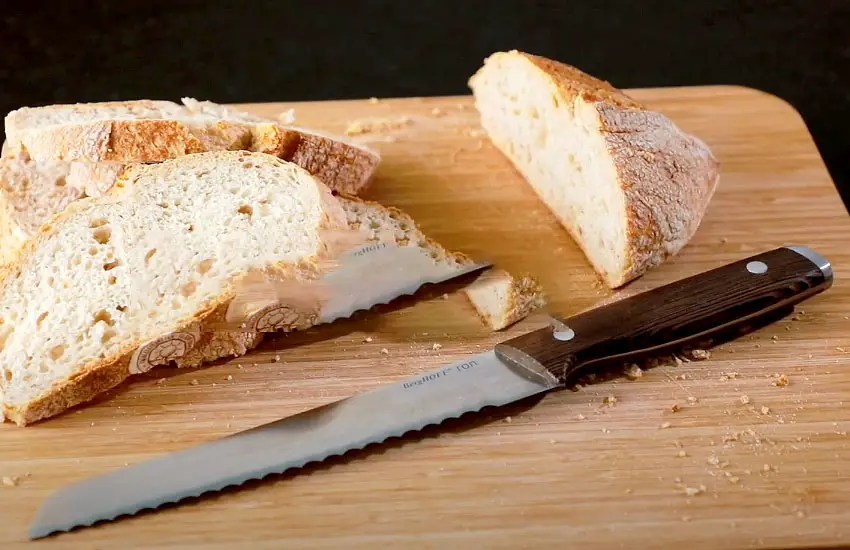
Consider the Blade Length
When it comes to choosing the right bread knife, one of the first factors to consider is the blade length. The blade length determines the versatility and functionality of the knife, allowing you to slice through different types and sizes of bread effortlessly.
Generally, bread knives come in various blade lengths, ranging from 8 inches to 10 inches. If you frequently deal with larger loaves or artisan bread, opting for a longer blade length will be advantageous. A longer blade will enable you to make clean and precise cuts through bigger loaves, ensuring a beautifully uniform slice every time.
On the other hand, if you primarily handle smaller bread or baguettes, a shorter blade length, such as 8 inches, would suffice. A shorter blade offers better control and maneuverability, allowing you to effortlessly navigate through narrow or curved surfaces without compromising on precision.
Evaluate the Handle Design
Another crucial aspect when choosing a bread knife is evaluating the handle design. The handle plays a vital role in ensuring your comfort and control while slicing through bread. It is essential to select a handle that fits comfortably in your hand and provides a secure grip.
There are various handle designs available, including wooden, plastic, and metal handles. Each has its own benefits and considerations. For example, wooden handles are aesthetically pleasing and offer a natural grip. However, they require extra care and maintenance to prevent damage.
Plastic handles, on the other hand, are lightweight, durable, and easy to clean. They are often a popular choice for commercial kitchens or those who prefer a low-maintenance option. Metal handles provide a sturdy and sleek look, but they may become slippery if not designed with proper grip features.
| Handle Material | Pros | Cons |
|---|---|---|
| Wooden Handles | Natural grip, aesthetically pleasing | Requires extra care and maintenance |
| Plastic Handles | Lightweight, durable, easy to clean | May lack the aesthetic appeal |
| Metal Handles | Sturdy, sleek look | May become slippery without proper grip features |
Ultimately, the choice of handle design comes down to personal preference and comfort. Consider how it feels in your hand and how confident you are in maintaining control while using the knife. Remember, a comfortable and secure grip will make your bread slicing experience more enjoyable and efficient.
Proper Grip and Technique
Achieving proper grip and technique is essential for using a bread knife effectively. Mastering the art of holding the knife and adopting the right cutting motion will ensure precise and effortless slicing of bread.
Hold the Knife Correctly
One of the most important aspects of using a bread knife is holding it correctly. The way you grip the knife can significantly impact your control and precision while cutting through bread. To hold the knife correctly, follow these simple steps:
- Place your dominant hand around the handle of the bread knife.
- Make sure your fingers are curved slightly around the handle, creating a firm yet comfortable grip.
- Position your thumb on the side of the handle, opposite your fingers, to provide stability and control.
- Ensure that your grip is secure but not too tight, allowing for flexibility and ease of movement.
Master the Sawing Motion
Once you have the proper grip, the next step is to master the sawing motion. This technique is crucial for achieving clean and even slices of bread. Follow these steps to perfect your sawing motion:
- Place the blade of the bread knife against the top crust of the bread at a slight angle.
- Apply gentle pressure with the knife while maintaining a steady hand.
- Begin sawing back and forth in a smooth and controlled manner.
- Keep the sawing motion consistent, applying equal pressure throughout the entire stroke.
- Continue sawing until you have sliced through the entire loaf of bread.
Remember to use your wrist and arm to generate the sawing motion rather than applying excessive force with your hand. With practice, you will find your rhythm and be able to slice through bread effortlessly.
Slicing Different Types of Bread
Each variety of bread requires a specific technique to ensure clean and precise slices. Let’s explore the best practices for slicing crusty artisan bread and soft, delicate bread that will elevate your bread cutting skills.
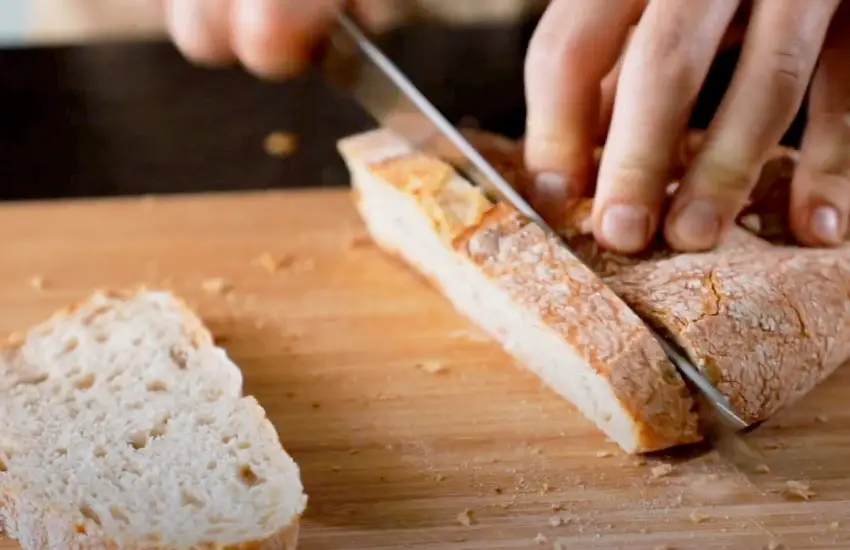
Crusty Artisan Bread
Slicing crusty artisan bread requires a careful approach to maintain its rustic texture and shape. Here are the steps to slice crusty artisan bread effectively:
- Start by choosing a quality bread knife with a serrated edge, as it will effortlessly cut through the crusty exterior without crushing the delicate crumb inside.
- Position the bread on a stable surface and hold it firmly with one hand to prevent any movement during slicing.
- Use a gentle sawing motion with the bread knife, allowing the serrated edge to cut through the tough crust while preserving the airy interior.
- Ensure uniform slices by applying even pressure and maintaining a steady pace as you slice through the entire loaf.
Soft and Delicate Bread
Slicing soft and delicate bread requires a different technique to prevent squishing or tearing. Here are the steps to slice soft and delicate bread with finesse:
- Opt for a sharp serrated bread knife with a thin blade to effortlessly glide through the soft texture of the bread without compressing it.
- Gently hold the loaf in place, using your fingertips to stabilize the bread while maintaining a light touch to prevent deformation.
- Employ a gentle back-and-forth motion with the knife, allowing it to effortlessly glide through the bread without exerting excessive pressure.
- Produce even slices by maintaining a consistent angle and practicing a smooth, controlled motion throughout the slicing process.
By following these specialized techniques for slicing crusty artisan bread and soft, delicate bread, you can enhance the presentation of your bread dishes and enjoy the full flavor and texture of each variety.
Final Words
Mastering the art of using a bread knife can enhance your culinary skills. With the right technique and practice, you can effortlessly slice through various types of bread. Understanding the proper grip, movement, and cutting angle are key elements to a seamless experience.
So, go ahead and elevate your bread-cutting game!


